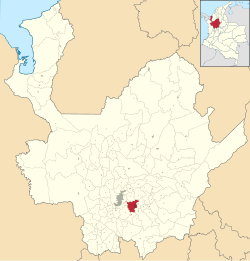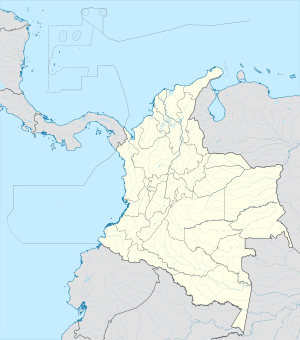Rionegro (Antioquia)
|
Rionegro Santiago de Arma de Rionegro |
|||
|---|---|---|---|

|
|||
|
|||
| Motto: Cuna de la democracia (Cradle of Democracy) | |||
 Location of the city (Marked in red) in the Antioquia region of Colombia |
|||
| Location in Colombia | |||
| Coordinates: 6°9′18″N 75°23′20″W / 6.15500°N 75.38889°W | |||
| Country |
|
||
| Departamento |
|
||
| Subregion | Eastern | ||
| Founded | 1541 | ||
| Government | |||
| • Mayor | Andrés Julián Rendón Cardona. | ||
| Area | |||
| • Total | 196 km2 (76 sq mi) | ||
| Elevation | 2,125 m (6,972 ft) | ||
| Population (2012) | |||
| • Total | 76,023 | ||
| • Density | 390/km2 (1,000/sq mi) | ||
| Demonym(s) | Rionegrero | ||
| Area code(s) | 57 + 4 | ||
| Website | Official website (in Spanish) | ||
Rionegro (Spanish pronunciation: [rioˈneɣɾo]) is a city and municipality in Antioquia Department, Colombia, located in the subregion of Eastern Antioquia. The official name of the City is "Ciudad Santiago de Arma de Rionegro" but is named after the Negro River which is the most prominent geographical feature of the municipality. Rionegro is also sometimes called the Cuna de la democracia (Cradle of democracy) as it was one of the most important cities during the era of the Colombia's struggle for independence and the 1863 constitution was written in the city.
The territory was first mentioned in 1541 by the Spanish Lieutenant Álvaro de Mendoza. When the Field Marshal Jorge Robledo took possession of the Valley of Aburrá, he was commissioned by Alvaro de Mendoza. According to Fray Pedro Simón, Robledo was the first Iberian man who discovered the Valley of San Nicolás on 2 September 1541.
Don Juan Daza, a Spaniard of illustrious lineage, took possession of the lands sometime later, and on 8 November 1581, in agreement with the rituals of the laws of Indias, nailed his sword in the ground marking it as an inhabited place and began constructing a farm.
Immigration to Rionegro came from numerous regions of the country, including from the same provincial capital of the time, Santa Fe de Antioquia and the original ranch grew into a village and then a town in the first half of the 17th century. The chapel, Concatedral de San Nicolás el Magno, consecrated to Saint Nicholas was built as early as 1642, another reason why the territory reached a greater degree of independence for religious reasons. In 1783, Rionegro had become like a municipality, resulting in becoming the City of Santiago de Arma de Rionegro in 1786, with administrative powers under certification of King Carlos III, issued in the Palace of San Idelfonso on 25 September 1786.
...
Wikipedia



